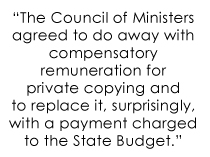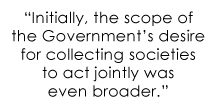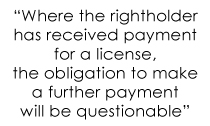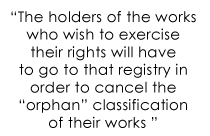 “With respect to the current stunted reform, the new legislation once again touches on past issues that were never properly resolved, and I am afraid that this is still the case now. The first is the zombie issue of private copying and the second salient point of the reform is piracy.
“With respect to the current stunted reform, the new legislation once again touches on past issues that were never properly resolved, and I am afraid that this is still the case now. The first is the zombie issue of private copying and the second salient point of the reform is piracy.
Other reforms regard the collecting societies, two new rights of remuneration (tax for Google and universities) and the implementation of directives on phonograms and orphan works.”
Table of Contents
1. Introduction
2. Objective of the Spanish reform
3. Private Copying
4. Piracy
5. Collecting Societies
6. Tax for Google and universities
7. Implementation of directives on phonograms and orphan works
1. Introduction
In recent years, most European countries have undertaken partial reforms of their intellectual property legislation. Over and above the duty to incorporate European laws into domestic legislation, or the hot issue of private copying, which is not just a Spanish problem, Europe on the whole is anxious to ensure that the legal copyright framework favours, and does not obstruct, the economic development of the digital economy.
Perhaps the best example of this concern is reflected in the copyright legislation review commissioned by the British Prime Minister, David Cameron, to Professor Ian Hargreaves back in November 2010. The assignment consisted of assessing whether the existing legal framework, which was supposedly geared towards guaranteeing incentives for innovation, was what was now required in order to achieve that objective, or whether it hampered its development.
Hargreaves concluded that the existing legislation required changes in order to enable emerging sectors to develop. He suggested that traditional contracting models had to change in order to facilitate the emergence of new businesses, and that all of this had to be implemented by establishing effective content protection mechanisms.
As well as putting forward specific proposals, the academic underscored the overriding need to construct future legal adaptations on this subject on the basis of facts and evidence, and to prevent lobby pressure from directing the changes without a clear perspective. Otherwise, I dare to add, IP reforms would continue to accumulate until that body of law became incomprehensible. This recommendation can certainly apply to Spain.
2. Objective of the Spanish reform
The Spanish Government has embarked on a reform dealing with the pressure (in any case warranted) to strengthen rights protection mechanisms, minimally patch up the burst seam of private copying that it itself had caused to come undone and subjecting collecting societies to tighter control.
Paradoxically, this same provision highlights that the actual areas to be amended (the private copying system, collective management and the competencies of the regulatory body) will have to be re-evaluated in that comprehensive reform.
We are therefore looking at a text which is not part of an action programme concerning content and culture industries; nor does it form part of a future design of the objectives to be achieved in this field.
3. Private Copying
With respect to the current stunted reform, the new legislation once again touches on past issues that were never properly resolved, and I am afraid that this is still the case now.
The first is the zombie issue of private copying. The Government had barely come into power when the Council of Ministers agreed, by Decree-Law of 30 December 2012, to do away with compensatory remuneration for private copying as provided under Article 25 of the Spanish Copyright Act, and to replace it, surprisingly, with a payment charged to the State Budget.
 The new regulation “suspiciously” stresses that the legislative option respects the principle of a fair balance between the amount of compensation and the damage caused, as required under the Community Directive, on the understanding that the damage must be limited to the actual harm caused to rightholders on account of the private copying exception.
The new regulation “suspiciously” stresses that the legislative option respects the principle of a fair balance between the amount of compensation and the damage caused, as required under the Community Directive, on the understanding that the damage must be limited to the actual harm caused to rightholders on account of the private copying exception.
Nevertheless, the fair balance principle, as explained in case-law from the Court of Justice of the European Union (CJEU), also comprises a connection between the payment and the beneficiary of the limitation. Paragraph 45 of the Padawan Judgment clearly indicates that “it is for the person who reproduces a protected work to make good the harm related to that reproduction”.
The judgment acknowledged, for practical reasons, that the distributors of reproduction equipment and devices could be considered as indirect debtors, taking very much into account the fact that they could pass on the cost of the levy, and that their distribution activities in respect of the recording equipment constituted the factual premise that enabled the copies to be made. Basically, the connection with the beneficiary of the limitation was maintained. That link required under the fair balance principle is nevertheless difficult to perceive when the State assumes the payment of compensation.
4. Piracy
The second salient point of the reform is piracy. The main changes in this regard consist of expanding the scope of the parties intervening in the provision of digital services subject to the control of the Comisión de Propiedad Intelectual (Intellectual Property Commission).
Rightholders had criticised the lack of action against links sites, drawing attention to the fact that the bulk of piracy was channelled through links sites to the detriment of peer-to-peer systems. The Judgment handed down by the Spanish National High Court on 22 July 2014 (in the Quedelibros case) had moreover called “action to restore legality” directed exclusively at links service providers into question. On the other hand, numerous judgments had declared the lawfulness of sites which merely offer links, i.e., links to third-party sites through which content can be accessed.
 However, among all of the circumstances that the regulating body had to take into account, the Svensson Judgment of February 2014 was of particular significance. That Judgment found there to be a problem with pursuing links as acts of public communication when the CJEU had declared that the act of providing links to protected works cannot be classed as an act of communication to the public when the link leads to works that can be freely consulted on the linked page. If it is not an act of public communication, action for infringement of copyright per se cannot be instituted; rather, the conduct would have to be described separately.
However, among all of the circumstances that the regulating body had to take into account, the Svensson Judgment of February 2014 was of particular significance. That Judgment found there to be a problem with pursuing links as acts of public communication when the CJEU had declared that the act of providing links to protected works cannot be classed as an act of communication to the public when the link leads to works that can be freely consulted on the linked page. If it is not an act of public communication, action for infringement of copyright per se cannot be instituted; rather, the conduct would have to be described separately.
The lawmaker’s response in the reform of the Copyright Act has not addressed all these problems with the clarity called for by communities of rightholders, but it does expressly mention that infringement proceedings can be directed against those who facilitate the location of works, considered separately, provided that they are not limited to mere technical intermediation activities.
Another new aspect of the administrative framework for curbing online copyright infringement is the establishment of duties aimed at the access provider along with other intermediaries such as those responsible for providing electronic payment and advertising services. The Commission will be able to order them to interrupt the services that they provide to the infringer, with failure to obey this order constituting a separate offence, punishable by payment of compensation.
5. Collecting Societies
The issue of collecting societies is another area that the Government felt had to be tackled urgently in order to establish a detailed system of obligations accompanied by the necessary penalties for infringing them. The provision imposes a new duty on all collecting societies to set up a “one-stop shop” as a means of reducing licensing transaction costs. It is easy to see the Spanish influence in the Directive on collective rights management in the wording of Recital 33, which is closely related to this initiative.
That provision warns that the European legislation is “without prejudice to the possibility for Member States to require collective management organisations established in their territory to issue joint invoices”.
Initially, the scope of the Government’s desire for collecting societies to act jointly was even broader. It involved joining licensing procedures in which a number of collecting societies had to intervene vis-à-vis the same user together under a single representative. All of them should work together. However, the final wording does not seem to pursue such an ambitious goal and its scope is limited, since it only requires the establishment of a one-stop shop centralising operations regarding invoicing and payment of the sums owed to the societies by users.
 The Government’s determination to perform a generalised review of the fees charged by collecting societies has been more solid, and the final wording has remained very close to the content of the initial bill. The societies will have to adapt their rates to a financial model whose principles have already been declared by CJEU and Spanish Supreme Court case-law concerning the analysis of the prices charged by collecting societies.
The Government’s determination to perform a generalised review of the fees charged by collecting societies has been more solid, and the final wording has remained very close to the content of the initial bill. The societies will have to adapt their rates to a financial model whose principles have already been declared by CJEU and Spanish Supreme Court case-law concerning the analysis of the prices charged by collecting societies.
The provision nevertheless refers to a future regulation on the development of the precise features of the financial assessment methods to which the collecting societies’ prices will have to be subjected.
6. Tax for Google and universities
When selecting topics in order to summarise the main aspects of the reform, I could not close this review without addressing the two rights of remuneration created by the reform of the Spanish Copyright Act.
The first is the so-called Google tax which has been designed as a new obligatory collective management right, is inalienable and primarily favours newspaper publishers.
The right stems from the use of fragments of news or entertainment content taken from publications or websites whose holders have been subjected to a limitation on their exploitation rights in order to permit such use. A similar provision cannot be directly inferred from the Information Society Directive, and since the list of limitations laid down in Article 5.3 of that Directive is a numerus clausus for the Member States, this will certainly give rise to problems concerning this provision’s conformity with European law.
 The second right of remuneration created ex novo by the lawmaker is compensation in respect of the limitation imposed on the holders of rights in printed publications for the distribution of partial copies of such works in universities or public research centres. The provision sets out the maximum amount that can be reproduced for the disposal of students or research staff, with this being specifically a chapter, an article of a journal or a piece which is of a length equivalent to 10% of the full work.
The second right of remuneration created ex novo by the lawmaker is compensation in respect of the limitation imposed on the holders of rights in printed publications for the distribution of partial copies of such works in universities or public research centres. The provision sets out the maximum amount that can be reproduced for the disposal of students or research staff, with this being specifically a chapter, an article of a journal or a piece which is of a length equivalent to 10% of the full work.
These new rights of remuneration which compensate for new limitations on rightholders’ exploitation rights do not prevent rightholders from executing licensing agreements for use that is more extensive than what can be accessed through this regulation. Nevertheless, where the rightholder has received payment for a license, the obligation to make a further payment will be questionable, in accordance with Recital 35 of the Information Society Directive 2001/29/EC.
7. Implementation of directives on phonograms and orphan works
The reform adds the transposition of two European Directives to the provisions described above.
The first is Directive 2011/77 of 27 September 2011, which extends the term of protection for phonograms from the 50 years provided under Directive 2006/116 to 70 years. The reform incorporates the Community statute of limitations in order to guarantee that performers will benefit from the extension. Once 50 years have elapsed since the publication of the phonogram, performers may terminate their contracts with the record companies if the latter do not guarantee the exploitation of recordings of their performances within a period of one year following the time when they are requested to do so. That exploitation must be via analogue or digital systems.
 The second is Directive 2012/28 of 25 October 2012, which facilitates the use of orphan works by cultural institutions and broadcasting organisations in the European Union. Orphan works are defined as being all those whose holders have not been identified, or even if identified, have not been located, after a diligent search has been carried out (Art. 37). It will once again be a regulation that determines the scope of the duty of due diligence and establishes the information sources that will have to be turned to in Spain.
The second is Directive 2012/28 of 25 October 2012, which facilitates the use of orphan works by cultural institutions and broadcasting organisations in the European Union. Orphan works are defined as being all those whose holders have not been identified, or even if identified, have not been located, after a diligent search has been carried out (Art. 37). It will once again be a regulation that determines the scope of the duty of due diligence and establishes the information sources that will have to be turned to in Spain.
However, the law does not remove the obligation to consult additional available sources in third countries where there is proof of the existence of information. That same administrative provision will establish the body that must register works of that category and the search procedures carried out by the organisations that wish to use the orphan works.
The holders of the works who wish to exercise their rights will have to go to that registry in order to cancel the “orphan” classification of their works and, where appropriate, receive fair compensation for any use that has been made.
PABLO HERNÁNDEZ
Head of the Media & Entertainment Area
ELZABURU
See also on KluwerCopyrighBlog.com: “A bill to amend the Spanish IP Law” by Raquel Xalabarder Plantada, Universitat Oberta de Catalunya (10 July 2014).
________________________
To make sure you do not miss out on regular updates from the Kluwer Copyright Blog, please subscribe here.


